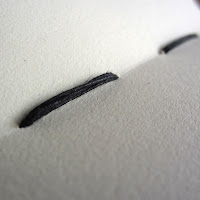 |
| Double needle Coptic binding. |
Here's what I've found.
Initially, as with any new technique, the binding process takes substantially longer although it's actually quite simple and not too dissimilar from single needle.
Because there are multiple threads dangling from each signature, it is quite a feat to keep the strands from tangling - and they do desire to tangle. The trick, if you don't have some sort of loom handy, is to allow them to dangle over the edge of your work table, using your legs to separate each pair (obviously, this works best if you have 6 binding holes, thus 3 pair).
My main interest in the double needle binding was visual - how would it visually differ from single needle binding. And a secondary concern was function - would it change the structure or functioning of a binding.
 |
| Top: Double needle Bottom: Single needle |
But the binding is more uniform with double needle - the links are full at each the head and tail of the spine. (Notice the difference between the far right band of links in the comparison photo.)
Another visual difference with double needle binding is the additional threading, which gives the threaded links along the spine more visual weight.
 |
| Thread passes back and forth multiple times in each sewing station. |
I find both of these things unsettling, as I prefer less bulk inside the signature and the tighter thread offered by single needle binding.
 |
| Knots inside the final signature. |
Overall, I find the double needle binding makes no substantial change to function or structure, yet enhances the internal orderliness and external visual strength of a book.
Although I will stick with single needle as my primary binding, I'll definitely be using double needle Coptic binding more frequently.

2 comments:
Interesting comparison, Amy. Thanks for sharing this. I do mainly the double needle binding, and I think within this type there are also variations. It looks like you might use a doubled thread, and that might add to the bulk you mentioned.
Thanks PrairiePeasant - I hadn't really thought about variations, so this afternoon I did another book in double needle and instead of passing through the signature twice which each thread, passed just once per thread. It sped up the process, reduced the bulk, and doesn't look any different from the outside!
Post a Comment